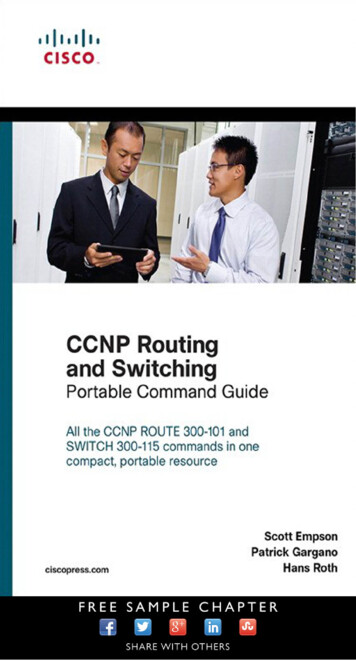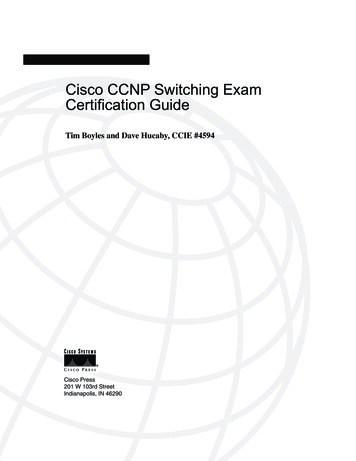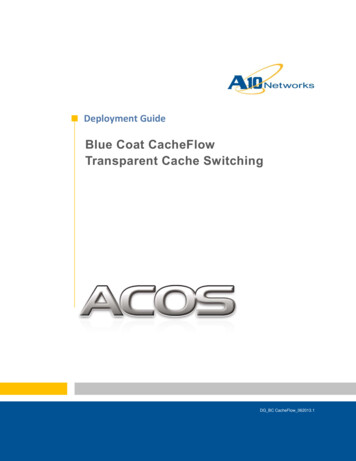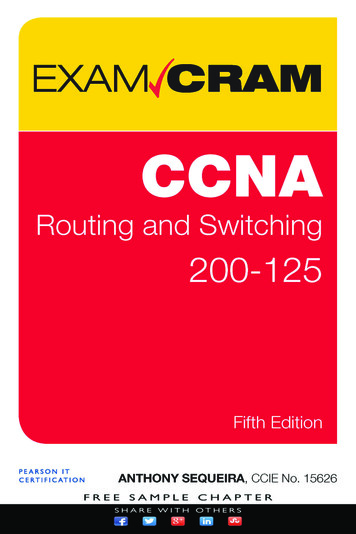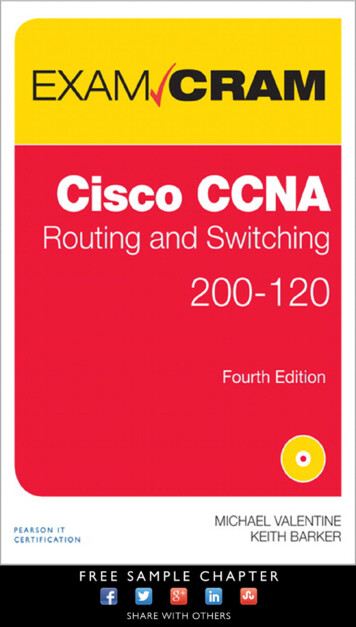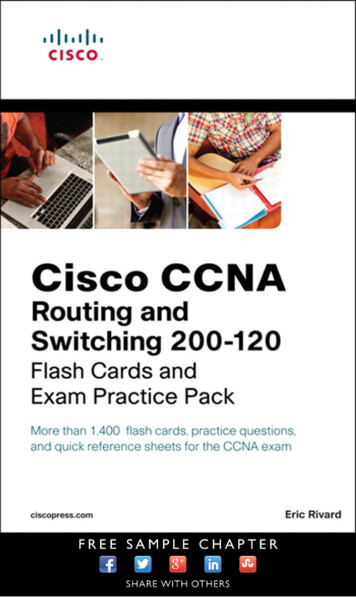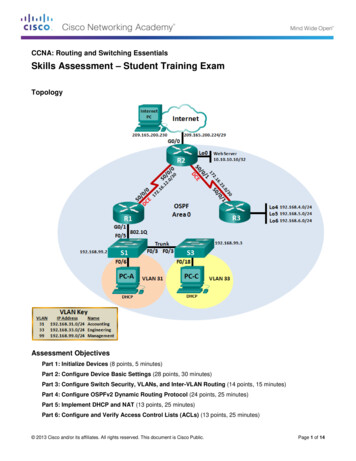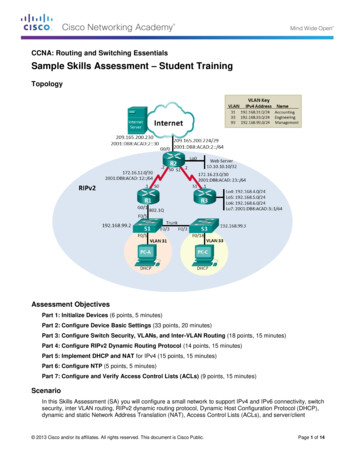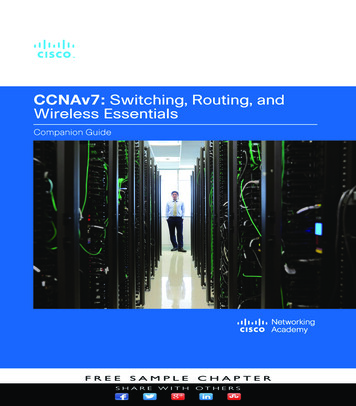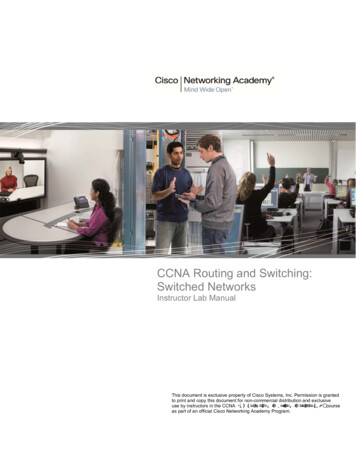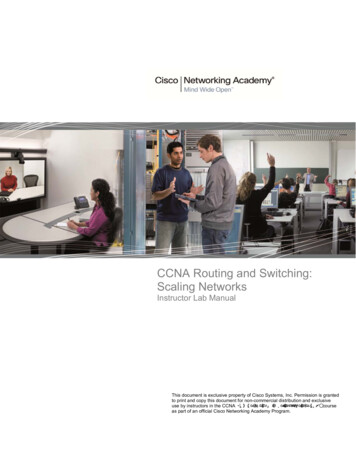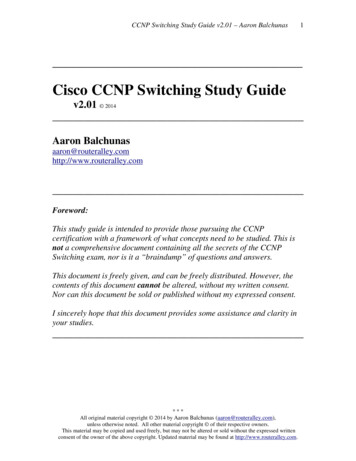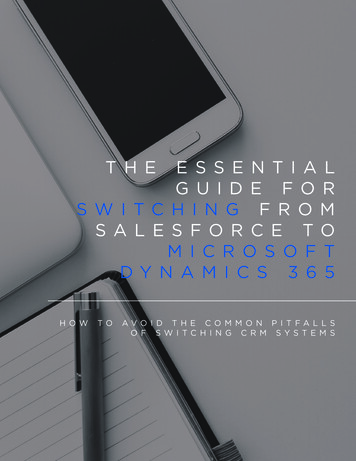
Transcription
T H EE S S E N T I A LG U I D E F O RSW I TC H I N G F R O MS A L E S F O R C E TOM I C R O S O F TDY N A M I C S 3 6 5H OWTOAVO I D T H E C O M M O N P I T FA L L SO F SW I TC H I N G C R M SYS T E M S
TA B L EP L A NT H EO FD E V I LO U TC O N T E N T SO FT H ED E TA I L SInvolving Key StakeholdersChange ManagementDeployment OptionsExpanding CRM FunctionalityS I M P L I F YYO U RM OV E&YO U RDATAData CleansingData ExportData Structured for NotesData Loading & ImportReport CleansingReport Export/BuildingCustom ReportsE X PA N DYO U RM OV E&YO U RDATADynamics 365 for Finacials & OperationsPortalsSharepointOffice 365PowerBIFlowAppsoucePowerAppsIntegration with External SystemsG E T E M P LOY E E S O N B OA R DT H R O U G H T R A I N I N G333456667888910101111111212121214Q U I C K LYDIY Dynamics 365 How-To PortalOnline Dynamics 365 How-To PortalDynamics 365 Boot Camp with PowerObjects14141414F I N A L15T H O U G H T S
IT HAS BEEN DE SC R IBE D BY M A N Y C R MSOFTWARE PROVID E R S AS A SIM PLE FLIPOF TH E SW ITCH, C HA N GIN G C R M SYST E M S.T HE TRU TH IS TH E R E A R E A LL TOO COM M ONPITFALLS TH AT CAN D E LAY OR D E R A IL YOU RSW ITCH IF YOU AR E N ’ T AWA R E OF T HE M ORHOW TO PLAN FOR T HE M . T HIS E BOOK WILLIDENT IT Y TH E FOU R K E Y A R E AS YOU M U STCAREFU LLY PLAN FOR TO M A K E YOU R SWITC HSU CCESSFU L FR OM SA LE SFOR C E TOMICROS OFT DY N A M IC S 3 65 .1
PLANTHEDEVILT H EOUTOFD E TA I L SSurprisingly, a successful switch from Salesforce to Microsoft Dynamics 365 hasjust as much to do with planning within your business as it does with planning forchange in the technology.With the majority of technology implementations falling short or even failing, thedevil is in the details, and we don’t mean making sure the right switch is turned onin a feature set. The success of technology has much to do with change management, key stakeholder buy-in and proper training to lead to the successful adoptionof your new CRM for Microsoft Dynamics 365 solution. Here is how to plan for success:INVOLVING KEY STAKEHOLDERSThe first best practice you can put into action to ensure your switch from Salesforceto CRM for Dynamics 365 is successful is getting the right parties and peopleinvolved early on in the planning process so that you have champions and advocates aligned when the switch is made.This includes everyone from your executive team down to your CRM end users.Having the executive team involved allows you to move forward with the supportand advocacy you need to drive user adoption for your new CRM system. Involvingyour current CRM users in the migration discussions from Salesforce to CRM forDynamics 365 ensures you will have the best knowledge of what contacts, data,functionality and structure to move from Salesforce to Dynamics 365.As you will learn in the later chapters of this guide, not all data or functionality inyour current system should be applied to your new system. Your CRM end usersare the best resource to help you filter through what should be migrated and whatshould be left behind.CHANGE MANAGEMENTOrganization-wide adoption of your new CRM for Microsoft Dynamics 365 solutionrequires you to prep, plan and execute the change with all the teams, departmentsand employees it impacts. Change management for your new system starts at thetop. Your executive team, likely your CTO or Director of Technology, needs to revealthe strategic reason you are making the switch to Microsoft Dynamics 365 and theplan for executing this change over as seamless as possible for employees.Of course, change management requires an abundance of upfront planning, so thatthe actual switch from Salesforce to Microsoft Dynamics 365 is simply following thedetailed plan you’ve laid out for your technical execution team from data migrationand user set-up through to employee training and successful user adoption.3
Here are some questions you should be asking yourself to properly plan for a successfulswitch to Dynamics 365:1.2.3.4.5.Do we have buy-in from all key stakeholders to make this transition successful?Is this the best time for my business to go through this change(e.g. not during year-end or peak sales times)?Do you have the proper support in place to get employees up to speed withtraining, documentation and user support to educate and accuratelyanswer questions?Have you planned an internal communication strategy to champion and promotethe benefits to have employees take a vested interest in the new system’ssuccess?How will you track, recognize and reward wins as employees interact with andevolve with your new system to drive better performance and efficiencies?The answer to these questions are key to drive the change management required for asuccessful Dynamics 365 adoption.DEPLOYMENT OPTIONSThere is more than one way to get online, or if you prefer on-premise, with CRM for Dynamics 365. Coming from Salesforce, the luxury of more than one deployment option isa pleasant surprise that is sometimes overlooked.There are actually three means of deploying CRM for Dynamics 365:41.CRM for Dynamics 365 Online. This deployment is the most similar to yourSalesforce CRM deployment. The greatest benefit with an online deployment isthat it provides you the flexibility to access your CRM data from anywhere and onany device connected to the internet.2.CRM for Dynamics 365 On-Premises. An On-Premises deployment is technicalspeak for deploying your CRM system on your own servers within your own datacenter. Historically, this is how most software systems have been installed andperhaps that is the reason you are choosing to migrate to CRM for Dynamics365. The greatest benefit to an On-Premises deployment is the direct access itprovides you to your data for closer integration, reporting and customization thatis difficult to achieve online or in “the cloud.”3.CRM for Dynamics 365 in a Private Cloud. Similar to an On-Premises deployment,this keeps your CRM for Dynamics 365 solution private, not in your data center,but your Partner’s private data center (PowerObjects does this for clients). Thegreatest benefit to deploying in a Private Cloud is that you don’t have to managethe infrastructure of managing services, but you still get the direct access to thedata for closer integration, reporting and customization as you would with anOn-Premises deployment.
There are obviously pros and cons for each method of deployment, so here are thecliff notes to help you decide which deployment option is best for your organization.DeplomentMethodsProsConsOnline Low initial cost of ownership Server/Infrastructure fullymanaged externally. Little IT overhead or dependency- Database storage limit is scaled- Added storage and licenses canbe costly- Limits on reportingOn-Premise Full control over environment,data and database Limitless reporting capabilities Query directly to database- High initial cost of ownership- Server/Infrastructure internallyrequired- Success highly dependent onInternal IT resourcesPrivate Cloud Some control over databaseand data Server/infrastructure fullymanaged externally Little IT overhead dependency Licenses or subscriptions available- Moderate initial cost of ownership with licensing- Added storage, reporting andcustomizationsis an expenseEXPANDING CRM FUNCTIONALITYSwitching from Salesforce to CRM for Dynamics 365 means migrating all your contacts, data and replicating your current CRM functionality. It also means you havethe opportunity to do more with your CRM, extending and expanding the functionality to serve you and your customers better.However, expanding or adding functionality during the migration from Salesforceto CRM for Dynamics 365 will impact timelines and increase the project complexity.Since you are already experiencing some level of disruption to your workforce, nowmay be the right time to expand the functionality to include all that your businesswill need moving forward. On the other hand, you may want to execute the straightmigration from Salesforce to CRM for Dynamics 365 to be running on your new system as quickly as possible before adding new functionality.You will have to decide what is best for your company and workforce, but there isdefinitely a plethora of options to add to your CRM for Dynamics 365 solution tomeet your expanding business needs.5
SIMPLIFY YOUR MOVE AND YOUR DATAPlanning ahead for how you will move your data out of Salesforce and into CRM forDynamics 365 will save you much angst down the line. As the old adage goes, “failingto plan is planning to fail.” While you likely won’t fail in migrating your data over to CRMfor Dynamics 365, you may end up migrating bad data, which can taint the data integrity of your new CRM system just as it did your old.Here are the considerations you should make when it comes to your migration and yourdata when switching from Salesforce to CRM for Dynamics 365.DATA CLEANSINGOver time, your CRM system has collected and housed legacy data that is no longerused or is inaccurate. It is also important to take note of how your data is currentlystructured and if the format of data storage has changed over time.To ensure this inaccurate or outdated data is not migrated to pollute your new systemand to consider the migration of legacy data that make need an updated data structure,you should formalize a data cleansing strategy prior to your migration. To define yourdata cleaning strategy, answer the following questions:1.2.3.4.5.What resources are available to cleanse my data?Who should be accountable for cleansing and checking the data(pre and post- migration)?Should the data be cleansed in Salesforce or exported then cleansed?What data should be migrated, archived and left behind?If migrating legacy data, will any data require data restructuring to migrate?Answering these questions will help you organize and simplify your data migration.DATA EXPORTWhen making the switch from Salesforce to CRM for Dynamics 365, your execution ofthe export of your data should also be planned. There are a few differences you shouldnote.KNOWN DATA EXPORT/IMPORT DIFFERENCESEXPORT FROMSALES FORCE:All fields for export must bemarked “visible”Some data may need to importas different custom entity typesNot all fields can be exportedNot all calculated or custom fieldswill be available for importSome entity types may not beavailible in Dynamics 365Record keys are case sensitive6IM PORT TODY N A M IC S 3 65 :Global Unique IDs (record keys)are not case sensistive
“ KNOWING AND RECOGNIZINGD A T A E X P O R T / I M P O R TDIFFERENCES WHENPLANNING THE SWITCH FROMS A L E S F O R C E T O C R M F O RDYNAMICS 365 HELPS PLANY O U R M I G R A T I O N A N DY O U R R E S O U R C E SA C C O R D I N G L Y .“
Knowing and recognizing these data export/import differences when planning the switchfrom Salesforce to CRM for Dynamics 365 helps plan your migration and your resourcesaccordingly.Beyond the differences identified above, the actual act of exporting data out of Salesforcecan be one of the more difficult aspects of switching to Microsoft Dynamics 365. You mayselect to export your Salesforce data by one of two options:1. Web Services Export: You may directly extract the data yourself using Salesforce webservices.2. Contact Salesforce: You may contact Salesforce to perform the export for you by requesting an extraction of all your data in .csv format. The .csv file will separate eachentity, including Accounts, Leads and other data.Once you have the data exports, you must take special care that your files contain all of theavailable data by cross-referencing how many files should be moved with the number ofactual files exported. This validation should be performed by business owners and shouldbe based on a timestamp for accuracy. For discrepancies in data, it is best to contactSalesforce directly for assistance.DATA STRUCTURED FOR NOTESOne stark difference to recognize between Salesforce and CRM for Microsoft Dynamics 365is the difference in data structures for notes. Whereas Salesforce has multiple fields to takenotes, Dynamics 365 only uses a single field. Hence, during your switch, all the notes fieldsmust be concatenated to preserve all notes as you migrate.DATA LOADING AND IMPORTParticularly for large enterprises that use an enormous amount of data, it is a good idea toplan the initial data load ahead of the targeted launch date of CRM for Microsoft Dynamics 365. A good rule of thumb is to schedule this process at least two weeks ahead of thelaunch.You should also schedule an incremental load the weekend before the scheduled launchdate to ensure the actual importing of data is executed quickly and smoothly.REPORT CLEANSINGCleansing your reports is just as important as cleansing your data. Migrating stale, out-ofdate reports will muddy the waters of your new CRM system, making it unclear to viewwhat is current and applicable for your employees to mine and dissect accurate data.As such, you should put into place a report cleansing strategy for the switch from Salesforce to Microsoft Dynamics 365. You should establish a report cleansing strategy, similarto your data cleansing strategy, for weeding out your outdated and inaccurate reports.Here are the questions you should be asking yourself to build your strategy:81.2.What resources are available to cleanse my reports?Who should be accountable for cleansing and checking the reports(pre and post- migration)?
3.4.5.Should the reports be cleansed in Salesforce or exported then cleansed?What reports should be migrated, archived and left behind?Will any reports need to be rebuilt if custom report options were used?If you still have questions about your report cleansing, reach out to your Microsoft CloudSolution Provider. Your Microsoft Partner is the best resource for all your data, reports andmigration related questions.REPORT EXPORT/BUILDINGAgain, reports work similarly to data when exporting from Salesforce. Proper planning cansave some long-term headaches with a few notable differences between systems concerning reports.KNOWN REPORT EXPORT/IMPORT DIFFERENCESEXPORT FROMSALESFORCE:IM PORT TODY N A M IC S 3 65 :Some report types may not beavailable in Dynamics 365(e.g. custom reports)Not all reports can be directlyimported (e.g. custom reports)Custom reports will need to berecreated, possibly using differententitiesSome legacy reports may not usecurrent data structure forexport/importNot all custom reporting solutionare available in Dynamics 365Consider these report exporting differences when planning the switch from Salesforce toCRM for Microsoft Dynamics 365 to plan your migration and your resources accordingly.Beyond the challenges identified above, the actual act of exporting reports from Salesforce can be done one of two ways:1.2.Web Services Export: You may directly extract the reports yourself using Salesforceweb services to .xls or .csv files.Contact Salesforce: You may contact Salesforce to perform the export for you byrequesting an extraction of all your data in .xls or .csv format.Once you have the report exports, you must take special care that your files contain all ofthe available data. For discrepancies in data, it is best to contact Salesforce directly forassistance.MICROSOFT PARTNERBEST RESOURCE FORU R DATA , R E P O R TSG R AT I O N R E L AT E DONS.““ YOURIS THEALL YOAND MIQUESTI9
CUSTOM REPORTSBeyond cleansing the standard reports, custom reports must be evaluated separately asthese reports will take more work than just a simple migration. First, analyze how oftenthese custom reports are used and if they will be utilized moving forward in your newCRM for Microsoft Dynamics 365 solution. If the reports will not be recreated, will theybe left behind or archived?Second, in order to recreate these custom reports, there are a number of customizationsand mappings that must be made. If you are currently using a custom reporting solution in Salesforce, will you want move that same solution to CRM for Microsoft Dynamics365?Third, can these custom reports be improved with further native functionality in Microsoft Dynamics 365? Again, working with your certified Microsoft Dynamics Partner willhelp you best determine the best plan of action moving forward with your custom reports.EXPAND YOUR CRM BREADTH WITH INTEGRATIONSLike Salesforce, CRM for Microsoft Dynamics 365 can be expanded far beyond thedepths of traditional CRM systems. To prepare for your switch from Salesforce to CRMfor Dynamics 365, make a list of integrations you currently use in Salesforce and decidewhich ones you would like to replicate when you make the switch.For each integration you’d like to replicate in Dynamics 365, here are the questions youshould be asking:1.2.Are the adapters/connectors available in CRM for Dynamics 365? If not, will theyhave to be developed?Is the data integration unidirectional or bidirectional?Answering these questions will help you decide how to move forward with integrationsin CRM for Dynamics 365.Dynamics 365 further integrates with many other services to expand the functionality ofyour CRM solution:DYNAMICS 365 FOR FINANCIALS AND OPERATIONS (ERP)CRM for Dynamics 365 also extends beyond traditional CRM functionality with nativebusiness applications within the Microsoft Dynamics 365 platform, which includes Enterprise Resource Planning (ERP) functionality using additional business applications forFinancials and Operations.Dynamics 365 for Financials builds upon your existing CRM capabilities with built-inquoting, invoicing, purchasing, payment, reporting, inventory tracking and more. Dynamics 365 for Financials provides you a more comprehensive view of your business datathan just CRM alone.10
Dynamics 365 for Operations also adds a layer to your existing CRM functionality, withnative warehousing, demand forecasting, e-commerce, budget planning, production floormanagement, POS system and more. Dynamics 365 for Operations delivers the key insights an ERP system provides to help you manage your growth.PORTALSIf you currently use a customer portal in Salesforce or an out-of-the-box web portal for anadditional cost, you will probably want to replicate that portal in CRM for Microsoft Dynamics 365.Dynamics 365 Portals provide a single point of access and central place to pull dynamicinformation for your CRM, allowing you to extend your business processes by providingyou similar functionality and external user access as your current customer portal in Salesforce.When switching to Microsoft Dynamics 365, you also have the ability to customize yourportal with .NET libraries, Silverlight, HTML files and more. If needed, PowerObjects canprovide custom Dynamics 365 Portal development.SHAREPOINTIf you are currently use a document storage solution in Salesforce, you will likely need aplace to store documents when you switch to CRM for Microsoft Dynamics 365.Microsoft SharePoint is a fully integrated document storage solution for CRM with Dynamics 365. SharePoint provides you with centralized access to your documents and resourcesfrom within CRM.Depending upon the deployment option you select for CRM for Dynamics 365, SharePointcan easily be integrated into the Cloud or on-premises.POWERPACK ADD-ONSThe PowerPack tools are designed to enhance the CRM capabilities of Microsoft Dynamics365, while providing even greater functionality and efficiency, all for just 1-2 per user, permonth.Developed based on the needs and feedback from our customers, the PowerPack toolsare not just simple customizations for sales productivity and marketing automation, butoffer true features to help you get the most out of your Dynamics 365 investment.OFFICE 365If you currently use Microsoft Word, Excel, PowerPoint or other Microsoft Office suiteproducts, these can also be easily integrated into CRM for Dynamics 365.By integrating Microsoft Office 365 with Dynamics 365, you will have single sign-on accessthrough identity federation. This also allo
from Salesforce to CRM for Dynamics 365 helps plan your migration and your resources accordingly. Beyond the differences identified above, the actual act of exporting data out of Salesforce can be one of the more difficult aspects of switching to Microsoft Dynamics 365. You may select to export your Salesforce data by one of two options: 1.
